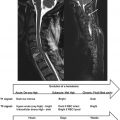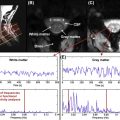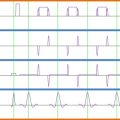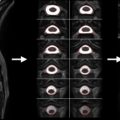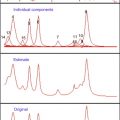Abstract
This chapter will introduce the q -space theory, which describes the behavior of water molecules probing their restricted environment without assuming a specific probability function of their spatial distribution. After describing the q -space theory, the advantages of q -space in an ideal scenario will be listed, especially with reference to the potential biophysical properties of quantitative metrics based on the probability density function. The chapter will then move onto ways of dealing with the limitations of applying the q -space theory in vivo using standard imaging systems. In particular, two issues will be highlighted: hardware limitations with regard to the currently available gradient systems and time constraints when scanning in vivo subjects. Spinal cord q -space applications will be described, referring to the limited literature available, especially with reference to the spinal cord issues that are introduced, cross-referencing the discussion with other chapters. Acquisition and processing strategies will be described, with specific reference to the spinal cord structure. A protocol suggestion for acquisition and analysis will be included.
Keywords
Axon diameter, Diffusion imaging, Microstructure, Q -space, Spinal cord
In Chapter 3.1 , the diffusion of water molecules was described according to the diffusion tensor model, which assumes a Gaussian probability of displacement associated to the diffusion of water molecules. This assumption is true in free systems, but it is also applied for water in complex biological structures. In this chapter, the q -space theory is explored as a model free from assumptions, and we discuss its limitations and its translation to in vivo applications to the spinal cord. One of the main advantages of q -space imaging (QSI) is that it allows probing of tissue microstructures with higher fidelity than diffusion tensor imaging (DTI) because of its sensitivity to restriction and hindrance.
All concepts relative to DTI are discussed in Chapter 3.1 , and it is assumed that the user is familiar with magnetic resonance imaging (MRI) diffusion experiments.
3.2.1
Q -Space Theory
Nonparametric approaches (e.g., those based on q -space theory) do not model the displacement probability explicitly and therefore give a more accurate representation of the diffusion mechanism in complex biological tissue. The notion that structural information is obtainable through the study of q -space has been pioneered by Refs and . The following derivation forms the basis of q -space analysis, where <SPAN role=presentation tabIndex=0 id=MathJax-Element-1-Frame class=MathJax style="POSITION: relative" data-mathml='P(r|r′,t)’>P(r∣∣r′,t)P(r|r′,t)
P ( r | r ′ , t )
is the conditional displacement probability of water (i.e., expressing the probability of a water molecule diffusing from position r to r ′ over the time period t ). In a pulsed gradient spin echo (PGSE) diffusion experiment (see Chapter 3.1 for details), if the diffusion gradient pulse duration δ is negligible compared to the diffusion time Δ ( δ ≪ Δ ), any motion of water molecules during the diffusion gradient time can be neglected. In this short gradient pulse (SGP) regime, the normalized echo attenuation S for a specific PGSE experiment can be expressed as the integral over all water molecules of the net phase shift of each molecule caused by the diffusion gradient vector g and diffusion gradient duration δ , weighted by the probability of its movement from r to r ′ during diffusion time Δ (also called the mixing time). Thus:
S ( g , δ , Δ ) = ∬ P ( r ) P ( r | r ′ , Δ ) exp [ − i · γ δ g · ( r ′ − r ) ] ⅆ r ′ ⅆ r ,
In a typical diffusion MRI experiment, the spatial dimension of the prescribed voxel is several magnitudes bigger than the length scale of diffusion motion. Hence, it is useful to consider the average displacement probability density function (dPDF) <SPAN role=presentation tabIndex=0 id=MathJax-Element-3-Frame class=MathJax style="POSITION: relative" data-mathml='P′(R,t)’>P′(R,t)P′(R,t)
P ′ ( R , t )
(often referred to as the “average propagator” ), describing the ensemble average probability of a particle moving the distance R during diffusion time t independent of starting position r within the voxel, which is defined as:
P ′ ( R , t ) = ∫ P ( r ) P ( r | r + R , t ) ⅆ r .
S ( g , δ , Δ ) = ∫ P ′ ( R , Δ ) exp [ − i · γ δ g · R ] ⅆ R .
Stay updated, free articles. Join our Telegram channel

Full access? Get Clinical Tree


